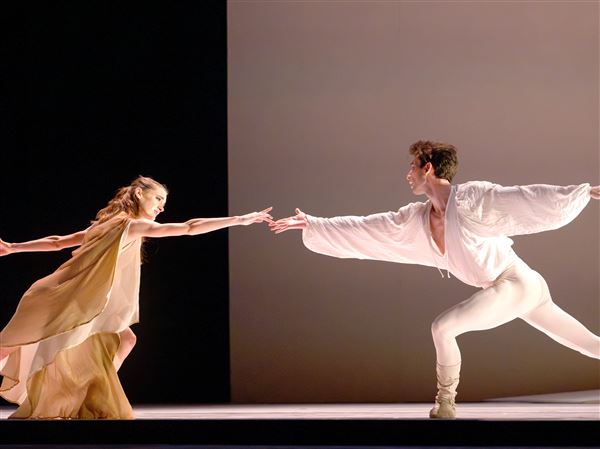After Charles Courtney Curran and Grace Wickham married in 1888, the young couple vacationed on Lake Erie’s southern shore. The artist, who grew up in Sandusky, Ohio, painted his bride and her cousin drifting in a rowboat through a cove filled with flowering water plants. He called the picture “Lotus Lilies.”
Lush flowers, young women and children appear often in the sun-drenched canvases that make up “Charles Courtney Curran: Seeking the Ideal,” a new exhibition at The Frick Pittsburgh in Point Breeze. These 60 paintings, on display through Feb. 1, are a perfect visual antidote to the omnipresent gray that descends upon Pittsburgh once fall colors fade into winter’s perpetual gloom. The Dixon Gallery and Gardens in Memphis, Tenn., organized the exhibition.
Some of the walls in the Frick’s first gallery have been painted a lemony yellow, a background that intensifies the golden and green hues on the canvases. There’s also a fine portrait of Mr. Curran, painted in 1931 by Alphaeus Cole, that shows the artist holding a palette. Nearby in a glass case is an actual palette Mr. Curran used. It’s fun to study it and see how he arranged his colors.
Where: Frick Art & Historical Center, 7227 Reynolds St., Point Breeze (15208)
When: Through Feb. 1; 10 a.m. to 5 p.m. Tuesdays through Sundays. For information: 412-371-0600 or www.thefrickpittsburgh.org.
Events: Events: Docent-led tours of the Charles Courtney Curran show will be offered today through Feb. 1 at 2 p.m. Wednesdays, Saturdays and Sundays. Tours are free and open to the public. •At noon Nov. 13, Sarah Hall, director of curatorial affairs, will give a talk titled “From Sirens to Suffragettes — Curran’s Women in Context” at The Frick Art Museum •At 10 a.m. Jan. 27, Amanda Dunyak Gillen, director of education, will talk about “The Art of Leisure” in the Lexington Education Center. Admission is $8 for members and $10 for nonmembers and guests. Advance registration and pre-payment are required. For more information on events related to this exhibition, go the Frick’s website.
By the time Mr. Curran died at the age of 81, his work had fallen out of favor. The year was 1942 and Abstract Expressionism dominated the art world. While his paintings have been exhibited in Impressionism shows, this is the first major retrospective of his work in 72 years. Many of the paintings in the show do not rely on size for their impact. “Lotus Lilies,” for example, measures 32 by 18 inches. However, “On the Heights,” one of his best-known works, is 30 by 30 inches.
The first picture, “Shadow Decoration,” is dated 1887 and shows a young woman hanging laundry on a clothesline. It takes a true idealist to find so much beauty in this tedious 19th-century chore. Mr. Curran also demonstrated his ability to create tight compositions and his masterful use of natural light. Sales of a series of scenes he painted of women at work gave him the means to marry and move to Paris in 1888. By the time he left the U.S., he had already trained at the National Academy of Design and the more liberal Art Students League in New York City.
During 2½ years in France, Mr. Curran studied at the Academie Julian and painted the Cluny and Luxembourg gardens. His 1889 painting “Paris at Night” is a perfect evocation of the belle epoque period, with its luminous lamps, elegant carriages and wet streets.
Mr. Curran experimented with the style of loose brush strokes popularized by the Impressionists and, like them, painted outdoors. A major influence on his work was French naturalist Pascal Dagnan-Bouveret. Like the Impressionist Camille Pissarro, whose friendship with Georges Seurat and Paul Signac led him to try pointillism, Mr. Curran eagerly embraced new ways to paint, dipping his brush into realism, symbolism and tonalism.
His genre scenes were popular with American collectors, including Henry Clay Frick. The industrialist bought an 1890 painting by Mr. Curran titled “Woman With a Horse and Carriage (Going for a Drive),” which is included in the show.
Around 1903, Mr. Curran and his family began spending their summers in Cragsmoor, a mountain hamlet and artists’ colony 90 miles northwest of New York City. In Cragsmoor, he built a home called Winahdin, which means “Thunder on the Mountain.” There, he painted “On the Heights,” a 1909 scene showing three young women sitting on a ridge of the Shawangunk Mountains.
When he wasn’t painting during the summer, Mr. Curran fenced and performed in local theater productions. He and his family vacationed in Cragsmoor for 40 years.
Grace Curran shared her husband’s love for the outdoors. She described that memorable summer day in the rowboat on Old Woman’s Creek in an 1897 St. Nicholas magazine article:
“The lotus spreads broad, velvety blue-green leaves in wide masses, and the huge, pale-yellow blossoms lift their queenly heads on high, and breathe forth on the air a delicate fragrance,” Mrs. Curran wrote.
In “Lotus Lilies,” the artist was, “equating women with beauty and idealizing them,” said Sarah Hall, director of curatorial affairs at The Frick Pittsburgh.
Marylynne Pitz: mpitz@post-gazette.com or 412-263-1648.
First Published: November 1, 2014, 4:00 a.m.
















